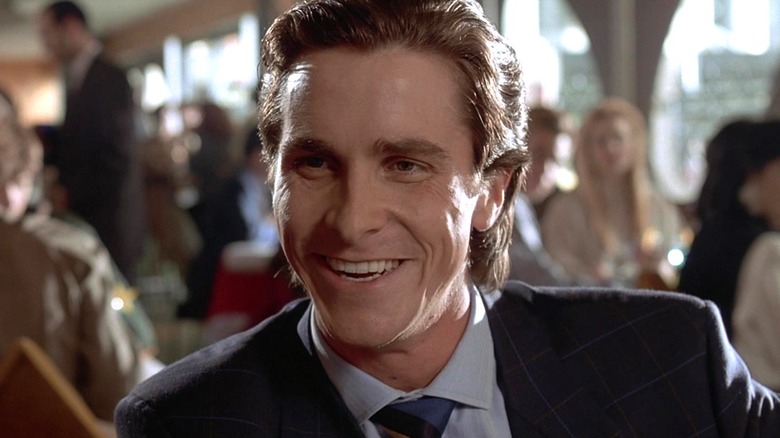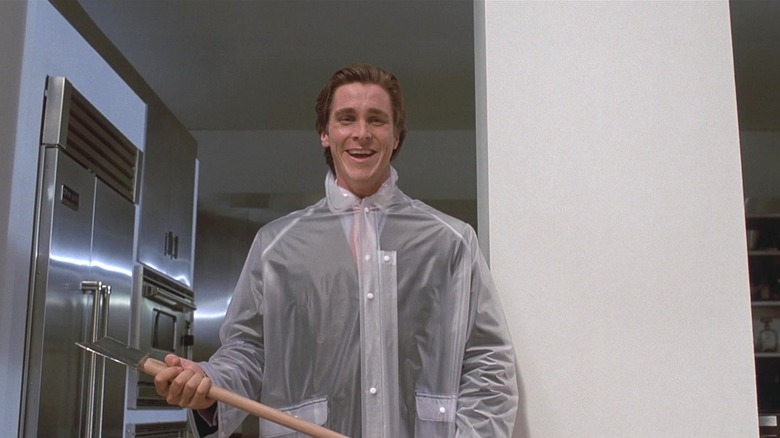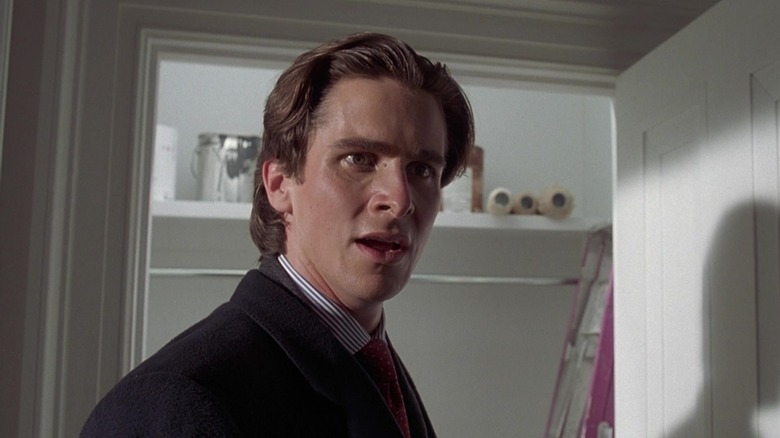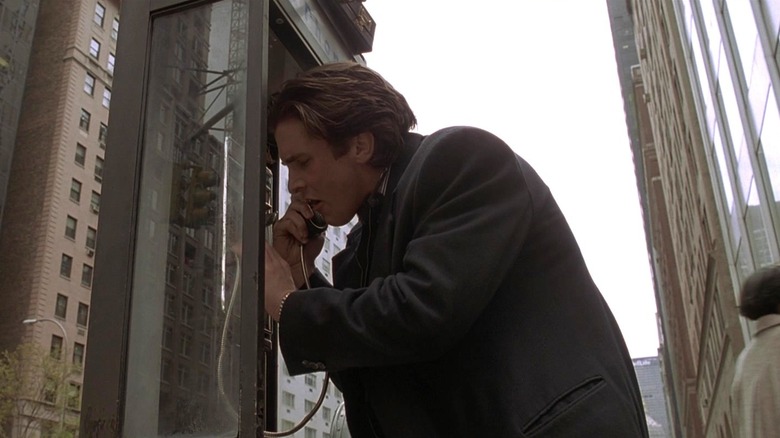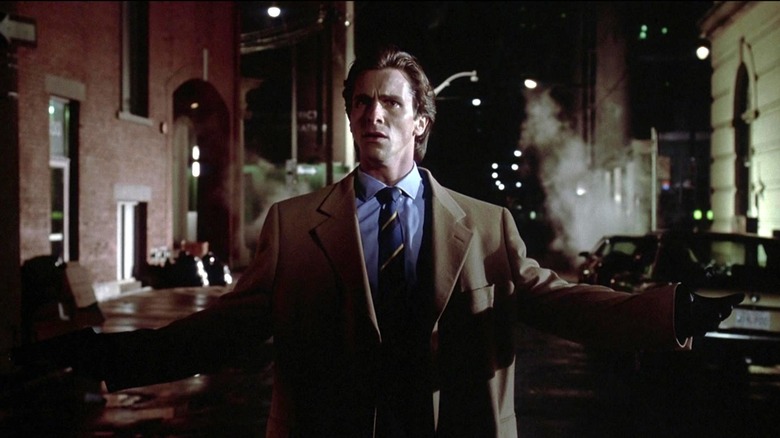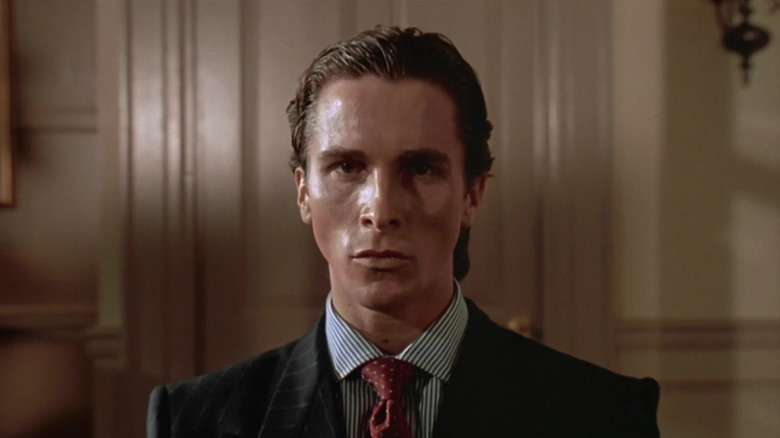American Psycho Explained: Breaking Down The Ending
"American Psycho," Mary Harron's 2000 adaptation of the infamous Bret Easton Ellis novel, was already mired in controversy before it completed shooting. Ellis' novel was so graphically violent, so loaded with misogyny, that many people thought the movie version would be something close to a snuff film. But Harron and co-writer Guinevere Turner turned in something much different — a darkly funny, only occasionally violent film that took the general essence of Ellis' book and reworked it into something different. Something, some people have even suggested, that was better than the book itself.
All these years later, the "American Psycho" movie has been studied and analyzed, and yet ... there are people who are still not entirely sure about the film's ending. That's by design: The conclusion is ambiguous enough that it can be read in different ways. If you still have questions, I am here to give you some answers — right after I return these videotapes.
Let's meet Patrick Bateman
In "American Psycho," we meet Patrick Bateman (Christian Bale), an investment banker living large in New York City in the 1980s. By day, he's a himbo — a very attractive guy who is also incredibly stupid. By night, he's one of cinema's creepiest serial killers. He murders homeless people, sex workers, and even people he knows (in the book, he also murders a child at the zoo, but that didn't make it into the film). The movie takes us through a few months in Bateman's life as we bear witness to his vapid, bloody existence. The only glimmer of humanity from the character comes in how he reacts to his secretary, Jean (Chloë Sevigny). Jean is clearly in love with Patrick, and while Patrick is incapable of love, he does end up sparing her life after coming very close to ending it (with a nail gun).
One of Bateman's many victims is Paul Allen (Jared Leto), a coworker that Bateman loathes. Bateman murders Allen with an ax in Allen's own apartment and leaves the body there. Later, he brings other victims to the apartment, killing them and hiding their corpses there as well. As the film progresses, Bateman becomes more and more unhinged, to the point where he calls his lawyer and confesses all his crimes. Realizing his blunder, Bateman decides to return to Allen's apartment and clean up the crime scene before it's too late.
What happens at the end of American Psycho
However, a curious thing happens when Bateman decides to cover up his killing spree ... the apartment is not the bloody mess that he left it. Instead, it's been cleaned to perfection — and it's currently on the market. A realtor is there, and she seems either afraid or angry at Bateman (the movie keeps it deliberately unclear; the bottom line is that she does not like Bateman, and she seems to know more than she's letting on). Bateman is confused, wondering what happened to all the dead bodies he left in the apartment.
Not long after this, Bateman runs into the lawyer he confessed to via phone. He tries to explain himself, but as it turns out, the lawyer doesn't even recognize him. This is a running theme in both the movie and the book (more so in the book): No one recognizes anyone. Everyone is so stupid and so coked-up that they're all living in a constant state of obliviousness. In addition to all that, the lawyer thinks the phone call was a prank — and he adds that Paul Allen can't be dead because he just had lunch with him in London. Bateman is understandably confused. Meanwhile, back at Bateman's office, Jean comes upon Bateman's journal, which is full of grisly drawings of his various victims.
Was it all in Patrick Bateman's head?
What are we to make of "American Psycho's" ending? There are commonly two interpretations here, and while I don't think either is "wrong," I personally think one is more accurate than the other. The first interpretation — and the one that I heard the most when the film first came out — is that almost everything that happened in the movie was in Bateman's head. This is an understandable conclusion — even if he's not a murderer, Bateman is clearly mentally unstable, so it's not a stretch to think he imagined everything that happened here.
The fact that Paul Allen's apartment was cleaned up and there was no talk of the dead bodies Bateman supposedly left behind, coupled with the drawings in Bateman's book, tends to make people think the film was one long hallucination. Bateman didn't really kill anyone, this theory states. He simply fantasized about it, and those drawings are his way of bringing those fantasies to life. Another element people use to back up this theory is a scene where Bateman shoots a cop car and the car explodes, leading Bateman to look at his gun, confused. Cars don't really explode when you shoot them — that only happens in the movies, thus Bateman's puzzled look.
If this is how you read the ending of "American Psycho," that's fine! Like I said, I don't think there's really a wrong answer. However, my interpretation is a little different.
Did Bateman really kill people?
The way I see it, Bateman really did kill all those people. Those actions weren't all in his head — they really happened. "But what of Paul Allen's apartment?!" you might ask. There's an explanation for that, and it makes the entire film even more horrific and disturbing. Yes, Bateman really did leave dead bodies in that apartment. However, the apartment is such a prime piece of New York real estate that the owner of the building hushed it up, got rid of the corpses, and is trying to rent it out without anyone knowing.
And the filmmakers back this idea up. Sort of. "To me and Mary [Harron], the book left it up in the air, too, what was real and what was not real," co-writer Guinevere Turner said to MovieMaker. "We didn't think that everything was real because some of it is literally surreal. But we just decided, together, that we both really disliked movies where the big reveal is that it was all in someone's head or it was all a dream."
What does the director of American Psycho say about the ending?
When Mary Harron was asked directly by MovieMaker if the entire film was in Bateman's head, she replied, "I would never answer that. As Quentin Tarantino says, 'If I tell you that, I take this movie away from you.' I will say there's a moment where it becomes less realistic, and that's the moment when the ATM says, 'Feed Me a Stray Cat.'"
However, when interviewed by Charlie Rose, she elaborated a bit more:
"One thing I think is a failure on my part is people keep coming out of the film thinking that it's all a dream, and I never intended that. All I wanted was to be ambiguous in the way that the book was. I think it's a failure of mine in the final scene because I just got the emphasis wrong. I should have left it more open ended. It makes it look like it was all in his head, and as far as I'm concerned, it's not."
The bottom line — while it's clear some things that happen in the film are in Bateman's head (like the "Feed Me a Stray Cat" scene), the murders actually happened. I personally prefer that interpretation because I feel like making the entire movie a figment of Bateman's imagination lets him off the hook. It says, "It's okay, none of that horrible stuff happened!" And that feels like a cheat to me.
"American Psycho" is available to rent or purchase on Amazon Prime Video.
